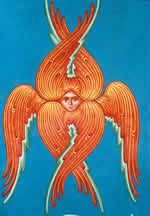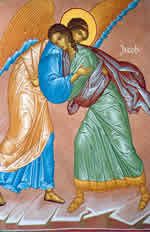/image%2F1464303%2F20240414%2Fob_6cc325_escaliercarte.jpg)
En septembre 1852, des sœurs de Lorette vinrent s’installer dans le sud-ouest des Etats-Unis, via le Kentucky, le Missouri et le Kansas.
Un voyage difficile et à hauts risques au cours duquel la supérieure, Mère Mathilde, décédera du choléra.
Elles se fixèrent à Santa Fe, Nouveau-Mexique.
Les sœurs Madeleine (elle sera nommée supérieure par Mgr Lamy), Catherine, Hilaire et Robert, s’installèrent dans une petite maison de briques, au milieu d’une population majoritairement composée de Mexicains et d’Indiens.
Leur premier souci sera de bâtir un couvent et une chapelle.
Elles firent donc appel à des charpentiers mexicains et, bientôt, une école sortit de terre : le collège de Lorette.
/image%2F1464303%2F20240414%2Fob_aa25c9_escalierdesantafe02.jpg)
La construction de la chapelle débuta le 25 juillet 1873 sur des plans de l’architecte Mouly qui avait dessiné la catédrale de Santa Fe.
Mgr Lamy étant français, il avait dans l’idée « quelque chose de similaire » à la Sainte-Chapelle à Paris !
Cette chapelle sera donc la première construction gothique à l’ouest du Mississippi.
Le bâtiment devait faire 8 m de large, 23 m de long, 26 m de hauteur. Il fut placé sous le patronage de saint Joseph.
La chapelle terminée, les sœurs s’aperçurent que si la réalisation était remarquable, une grossière erreur avait été faite : aucune liaison n’avait été prévue entre la tribune et la chorale.
Aucune cage d’escalier et, compte tenu de la hauteur de la tribune, impossible d’en installer un !
Sœur Madeleine fit appel à de nombreux charpentiers pour essayer de résoudre le problème. En vain.
Certains proposèrent de mettre une échelle, d’autres de raser tout l’édifice pour le reconstruire. Les sœurs, elles, préférèrent faire une neuvaine. Et d’attendre pour voir.
Le dernier jour de la neuvaine, un homme âgé, qui poussait un âne chargé d’outils, proposa de construire un escalier. Cela lui fut accordé, bien sûr.
En fait d’outils, l’homme n’avait qu’une scie, un marteau et une équerre en té. Au bout de six mois, le travail fut terminé. Et l’homme disparut du jour au lendemain. Sans laisser de traces. Et sans avoir demandé le moindre sou.
Mère Madeleine, soucieuse d’acquitter sa dette, se rendit à la scierie pour payer le discret charpentier et la commande de bois.
Mais là, surprise : personne ne connaissait l’homme et aucun document ne concernait une commande de bois pour la chapelle.
/image%2F1464303%2F20240414%2Fob_e5984f_escalierdesantafe05.jpg)
Premier mystère.
Le second, et non des moindres, concerne l’escalier. C’est un véritable chef-d’œuvre qui fait deux tours complets (2 x 360°) sur lui-même.
A la différence de la plupart des escaliers circulaires, il n’a aucun pilier pour le soutenir. Ce qui veut dire qu’il est suspendu sans aucun support.
Tout son poids repose sur la première marche.
/image%2F1464303%2F20240414%2Fob_7f7d64_escalierdesantafe04.jpg)
Sœur Florian, OSF, qui a laissé un récit de cette « miraculeuse » histoire (Magazine Saint-Joseph, avril 1960), écrit :
« Plusieurs architectes ont avancé qu’il aurait dû s’effondrer sur le sol au moment même où la moindre personne se serait aventurée sur la première marche. Et il a cependant été utilisé quotidiennement pendant plus de cent ans.
L’escalier a été assemblé exclusivement par des chevilles en bois : il n’y a pas un seul clou. La partie située sous les marches et entre le limon et la crémaillère ressemble maintenant à du bois léger.
C’est en réalité du plâtre mélangé à du crin de cheval destiné à donner de la rigidité. Trop nombreux sont les visiteurs à avoir succombé à la tentation de rapporter chez eux un souvenir, et d’avoir pour cela arraché à l’escalier des morceaux de plâtre. En 1952, lorsque les sœurs ont fêté le centenaire de leur arrivée à Santa Fe, elles ont remplacé le plâtre, et l’ont peint de manière à lui donner l’aspect du bois vernis. »
/image%2F1464303%2F20240414%2Fob_d1eefb_images-6.jpeg)
A l’époque de sa construction, l’escalier n’avait pas de rampes. Elles furent ajoutées cinq ans plus tard.
L’une des jeunes filles qui se trouvaient alors au collège avait 13 ans. Plus tard, elle deviendra sœur Marie chez les Sœurs de Lorette. Elle a expliqué comment elle et ses camarades furent sans doute les premières à utiliser l’escalier :
— Mais nous avions tellement peur de monter à la tribune que nous en redescendions sur les mains et sur les genoux.
Des milliers de visiteurs sont venus – et du monde entier – pour examiner cet escalier mystérieux. Parmi eux, de très nombreux architectes. Tous ont confié qu’ils ne comprenaient absolument pas comment l’escalier avait été construit. Ni comment il avait pu rester en aussi bon état après des dizaines d’années d’utilisation.
/image%2F1464303%2F20240414%2Fob_c52802_c6ecb3d0.jpg)
Sœur Florian explique encore :
« J’ai parlé de l’escalier avec monsieur Urban C. Weidner, architecte de la région de Santa Fe et expert en boiseries. Il m’a dit qu’il n’avait jamais vu un escalier circulaire sur 360° qui ne soit pas supporté par un pilier central. L’une des choses les plus surprenantes à propos de cet escalier, c’est, selon monsieur Weidner, la perfection des courbes des limons. Il m’a expliqué que le bois est raccordé (en menuiserie on dit « enté ») sur les côtés des limons par neuf entures sur l’extérieur, et sept sur l’intérieur. La courbure de chaque pièce est parfaite. Comment cela a-t-il été réalisé dans les années 1870, par un homme travaillant seul, dans un endroit retiré, avec des outils des plus rudimentaires ? Cela n’a jamais été expliqué. »
De nombreux experts en bois ont tenté d’identifier le bois utilisé, de deviner son origine.
/image%2F1464303%2F20240414%2Fob_11fe50_escalierdesantafe06.jpg)
Sans trouver de réponses. Les marches, inlassablement utilisées pendant plus d’un siècle, ne présentent des signes d’usure que sur le bord. Un de ces experts pense avoir identifié ce bois comme « une sorte de pin granuleux sur les bords ». Reste que ce bois au grain dur ne vient pas du Nouveau-Mexique.
« Notre Mère la Sainte Eglise est toujours très circonspecte lorsqu’il s’agit de juger des choses surnaturelles. C’est pourquoi les sœurs et les prêtres de la région de Santa-Fé ont évité, dans le même esprit, de dire quelque chose de définitif à propos de l’escalier. Les sœurs du collège de Notre-Dame de Lorette savent aujourd’hui, comme le disaient déjà sœur Madeleine et sa communauté, que l’escalier était la réponse de saint Joseph à leurs prières. Beaucoup se plaisent à penser que le charpentier était saint Joseph lui-même. Pourtant, les annales de la communauté comme les archives diocésaines sont silencieuses sur le sujet : les annales nous apprennent cependant que la chapelle Notre-Dame-de-Lumière a été dédicacée le 25 avril 1878 », rappelle sœur Florian.
Informations complémentaires
La controverse s'alimente à trois sources au moins :
— Un livre de Mary Jean Cook. Elle attribue, au terme d'une enquête privée et non authentifiée, la construction de l'escalier à Jean-François Rochas à partir de la rubrique nécrologique parue le 6 janvier 1896 dans le journal New Mexican Santa Fe et qui, rendant compte de la découverte du cadavre assassiné de l'intéressé, mentionne qu'il était « honorablement connu à Santa Fe comme expert en bois, et qu’il avait construit le bel escalier de la chapelle de Lorette ».
— Un article de Joe Nickel, paru dans le Magazine de l'Enquêteur sceptique (nov.-déc. 1998), intitulé : « La spirale vers le Ciel : l'escalier tient debout, mais le mythe s'effondre ». Beaucoup d'explications techniques pour étayer un raisonnement partial et assez pauvre.
— Un autre site fait mention d'un certain Oscar Hadweiber, maître charpentier, qui, en 1965, est subjugué par la beauté de l'escalier. Il annonce avoir trouvé en 1970, dans le grenier de sa sœur, la preuve que son grand-père Johan, lui aussi maître charpentier, et qui avait circulé au Colorado et au Nouveau-Mexique à l'époque de la construction de la chapelle de Lorette, était bien l'auteur de l'escalier. Rien n'a été authentifié. Et Oscar est décédé en 1980.
Le collège de Lorette a été fermé en 1968, et la propriété a été vendue aux enchères. Au moment de la vente en 1971, la chapelle de Notre-Dame-de-Lumière fut retirée du culte catholique. L'accès à la tribune a été interdit en 1970. Non pas à cause de la vétusté de l'escalier, mais en raison de l'application stricte des normes de sécurité : la tribune n'avait pas d'issue de secours…
La chapelle de Lorette est désormais un musée privé maintenu et entretenu, en partie, pour la conservation de l'Escalier Miraculeux et de la chapelle elle-même. Elle sert encore aux mariages « romantiques ».
Alain Sanders
— Références : http://www.christ-roi.net
/image%2F1464303%2F20240414%2Fob_226ef7_comic-book-cover.jpg)
Petite chronologie
— 1622, l’église Saint-Francis de Santa Fe est construite.
— 1812, l’ordre des Sœurs de Lorette est fondé le 25 avril dans le Kentucky.
— 1823, le Mexique gagne son indépendance sur l’Espagne.
— 1848, la partie sud-ouest des Etats-Unis lui est cédée.
— 1849, le Vicariat du Nouveau-Mexique est établi, et confié à monseigneur Jean-Baptiste Lamy.
— 1852, les Sœurs de Lorette répondent à l’appel de monseigneur Lamy qui demande des renforts pour instruire ses ouailles, en envoyant six sœurs enseignantes.
— 1853, premiers bâtiments du collège.
— 1854, le collège reçoit ses premières élèves.
— 1855, des sœurs supplémentaires arrivent à Santa Fe.
— 1856, un troisième groupe de sœurs arrive à Santa Fe.
— 1870-1880, construction de l’actuelle cathédrale Saint-Francis.
— 1873, début des travaux de la chapelle.
— 1878, fin des travaux de construction de la chapelle.
Indications bibliographiques
Albach, Carl R. (1965) Miracle ou merveille de la construction ? Réimpression à partir d’un mémoire d’ingénieur conseil.
Bobin, Jay (1998). L’escalier, rétrospective télévisée, The Buffalo News, 12 avril, pp1, 24-25.
Bullock, Alice (1978), Lorette et l’escalier miraculeux, Santa Fe, N.M., Sunstone Press.
Easley, Forrest N. (1997), Une montée d’escalier du Ciel ? (Impression privée).
Knight, Christopher (1997) « Juste qu’elle sorte de bois… ? » Wall Street Journal.
The Staircase (Ann Rinaldi, roman), Gulliver Books.
The Staircase. Téléfilm CBS 12/04/98. Barbara Herschley. David Caradine.
« La Escalera de San José » in San José Revue (Buenos Aires), 1986.
« The Mysterious Staircase of Santa Fe », in Liguorian Revue (1979, Liguori-Missouri).
/image%2F1464303%2F20240414%2Fob_28ab03_dessin.jpg)
Compléments
1- L’escalier, qui fait près de six mètres de haut, fait deux tours complets autour de son axe avant d’atteindre le chœur. Il a été construit sans aucun clou ni colle, et ne comprend aucune forme de support central. La construction en elle-même est qualifiée d’ “impossible”.
D’après certains, elle aurait dû s’effondrer dès la première utilisation, même si l’on suppose que la spirale centrale de l’escalier est assez étroite pour servir elle-même de support central.
En tout état de cause, il n’y avait à l’origine aucune attache au mur. C’est seulement en 1887, c’est-à-dire dix ans plus tard, que l’on ajouta la rampe et que la spirale extérieure fut fixée au pilier le plus proche.
2- L’ouvrage mesure un peu plus de 6 mètres de haut, et semble défier les lois de la gravité.
Pour couronner le tout, l’une des choses qui avait fortement intrigué ceux qui se sont intéressés à l’escalier en question est que l’essence de bois utilisée est une variété d’épicéa. L’épicéa, c’est un arbre commun… en Europe (pas du tout aux USA, encore moins au Nouveau-Mexique).
Autre énigme, les experts semblent avoir du mal à identifier la sous-espèce précise d’épicéa utilisée.
Il est à noter que l’ouvrage fut ultérieurement renforcé par le biais d’un ancrage à une paroi via un support métallique, et également agrémenté d’une rambarde, car malgré leur foi évidente, les sœurs eurent parfois quelques frayeurs en empruntant l’escalier (sans doute parce que personne ne leur avait appris comment utiliser ce type d’escalier).
3- Petit cours de technologie des escaliers pour un matheux qu'a rien compris.
/image%2F1464303%2F20240414%2Fob_8aae2b_escal10.gif)
Tout escalier, quelle que soit sa forme est contenu dans une "cage" carrée ou circulaire (en général fonction du lieu d'implantation). Il comprend un certain nombre de marches déterminé par la hauteur entre la base et le sommet sachant que la hauteur entre deux marches successives normal est comprise entre 16 et 20cm (les personnes âgées apprécient un escalier "doux" dont la hauteur de marche est inférieure à 20 cm qui leur évite de lever le pied trop haut).
Les marches sont tenues en place au moyen d'un assemblage de pièces de bois qui court à leurs deux extrémités. Cet ensemble de pièces de bois assemblées s'appelle un "limon".
Suivant le type d'escalier le limon est droit ou courbe. Une longueur continue d'escalier s'appelle une "volée" et le réglage de l'escalier (nombre de marches, hauteur de marche constante) se nomme "balancement".
Dans le cas de l'escalier de St Joseph nous avons un balancement sur 33 marches avec un double limon circulaire.
Le limon intérieur, évidemment // à celui de l'extérieur, est quasiment droit ce qui en fait une sorte de pilier central sur lequel repose l'escalier. Ici la hauteur de marche est comprise entre 20 et 20,35 cm (671cm/33=20,33...).
Premier mystère. Le second, et non des moindres, concerne l’escalier.
C’est un véritable chef-d’œuvre qui fait deux tours complets (2 x 360°) sur lui-même. A la différence de la plupart des escaliers circulaires, il n’a aucun pilier pour le soutenir.
Ce qui veut dire qu’il est suspendu sans aucun support. Tout son poids repose sur la première marche.
4- On voit bien que le nombre de marches (33) n'a rien de symbolique mais résulte de la contrainte technique.
L'escalier étant hélicoïdal d'une seule volée il n'est pas difficile d'imaginer le développé des limons (un peu plus difficile à tracer).
Je m'y connais un peu en escalier, techniquement avec un limon intérieur découpé en hélice ( noyau) comme vu sur la photo cela peut être réalisable et fait office comme une colonne centrale.
Mais réaliser cet ouvrage sans clous, vis ou colle, et en plus en épicéa ( un sapin très fissile, tendance à se fendre ) même pour un ouvrier chevronné reste de la haute voltige.
Le faire avec des outils manuels, s'il était seul, est presque irréalisable, ( découpe du noyau central)
Tout artisan bois sait que la hauteur de référence d'une marche d'escalier est de 180 mm.
6000 : 33 marches = 18,1818182 ...surprenant !
Qu'il ait tenu également 10 ans sans rampe qui reparti les efforts sur plusieurs marchés est aussi incompréhensible.
/http%3A%2F%2Fwww.christ-roi.net%2Fimages%2F9%2F98%2FEscalierDeSantaFe05.jpg)
A la fin du XIX° siècle, à Santa-Fé (Nouveau Mexique, Etats-Unis), un mystérieux charpentier réalise un escalier à la tenue inexplicable. Parmi les miracles reconnus, ceux qui sont attribué...
http://www.christ-roi.net/index.php/L%27escalier_de_Santa_Fe
/https%3A%2F%2Fwp.fr.aleteia.org%2Fwp-content%2Fuploads%2Fsites%2F6%2F2018%2F12%2Fweb3-loretto-chapel-staircase-jim-buzbee-shutterstock.jpg%3Fw%3D620%26h%3D310%26crop%3D1)
Le mystérieux escalier construit par saint Joseph au Nouveau-Mexique
La chapelle de Lorette, à Santa Fe au Nouveau-Mexique (États-Unis), abrite un chef-d'œuvre de menuiserie... attribué à saint Joseph.
https://fr.aleteia.org/2016/07/29/le-mysterieux-escalier-construit-par-saint-joseph/
/https%3A%2F%2Fupload.wikimedia.org%2Fwikipedia%2Fcommons%2Fthumb%2F4%2F41%2F%D0%A7%D0%B0%D1%81%D0%BE%D0%B2%D0%BD%D1%8F_%D0%9B%D0%BE%D1%80%D0%B5%D1%82%D1%82%D0%BE.jpg%2F1200px-%D0%A7%D0%B0%D1%81%D0%BE%D0%B2%D0%BD%D1%8F_%D0%9B%D0%BE%D1%80%D0%B5%D1%82%D1%82%D0%BE.jpg)
Chapelle de Lorette - Wikipédia
La chapelle de Lorette (en anglais : Loretto Chapel), est une chapelle située à Santa Fé au Nouveau-Mexique qui est connue pour son escalier en colimaçon, un remarquable travail de charpenterie...
/https%3A%2F%2Fmediaproxy.snopes.com%2Fwidth%2F1200%2Fhttps%3A%2F%2Fmedia.snopes.com%2F2014%2F03%2Floretto.jpg)
Mysterious Staircase at Loretto Chapel
Does a stairway at Santa Fe's Loretto Chapel miraculously stand despite having no discernable means of support?
/https%3A%2F%2Fride-your-life.fr%2Fwp-content%2Fuploads%2F2022%2F09%2FLa-Chapelle-de-Loretto.jpg)
La Chapelle de Loretto et son Escalier Miraculeux - Ride Your Life | Webmagazine
La Chapelle de Loretto, située à Santa Fe au Nouveau-Mexique, est mondialement connue pour son Escalier que d'aucuns qualifient de miraculeux.
S'abonner au Blog Seraphim
Cliquer ICI





/image%2F1464303%2F20240414%2Fob_69b19f_sn-x1000-pad-750x1000-f8f8f8.jpg)
/https%3A%2F%2Fwww.guichetdusavoir.org%2Fmedia%2Fcache%2Fthumb_illustration_bloc%2Fstaircase-274614-1920-60ae04fa22edd743956404.jpg)
/http%3A%2F%2Fwww.countrymusicattitude.com%2Farticles%2FIMAGES%2Fescalier%2Fescalier010.jpg)


/image%2F1464303%2F20240411%2Fob_37ade4_triquetra.jpg)
/image%2F1464303%2F20240411%2Fob_917c1a_il-570xn-2838813564-4cdu.jpg)
/image%2F1464303%2F20240411%2Fob_0c270b_trinity-knot-in-forest-1.jpg)
/image%2F1464303%2F20240411%2Fob_0af08b_trinity-knot-church-1.jpg)
/https%3A%2F%2Fwww.celtic-weddingrings.com%2Fimg%2Fcms%2Ftrinity-knot-meaning.jpg)
/https%3A%2F%2Farchive.org%2Fservices%2Fimg%2Fearlychristianmo12alle)
/image%2F1464303%2F20240414%2Fob_275324_transfiguration-of-jesus.jpg)